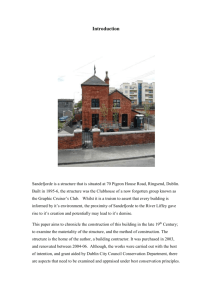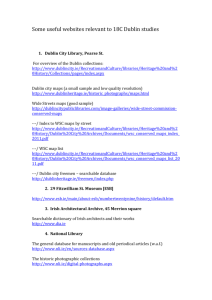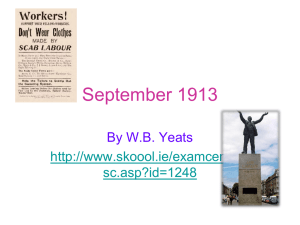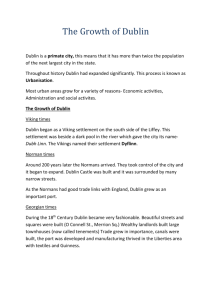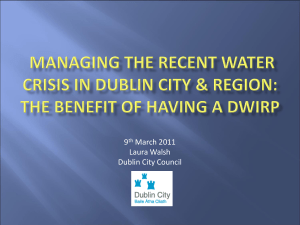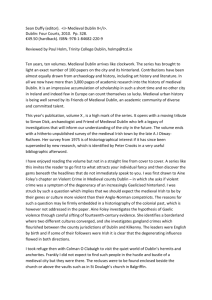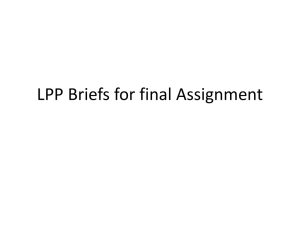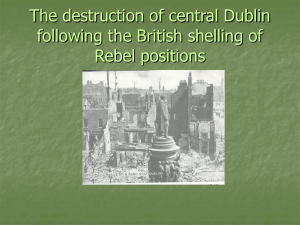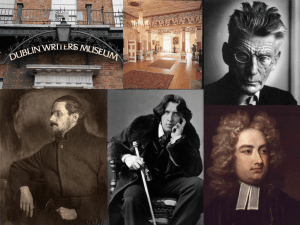Dublin`s Timeline by Stephen O Connor
advertisement
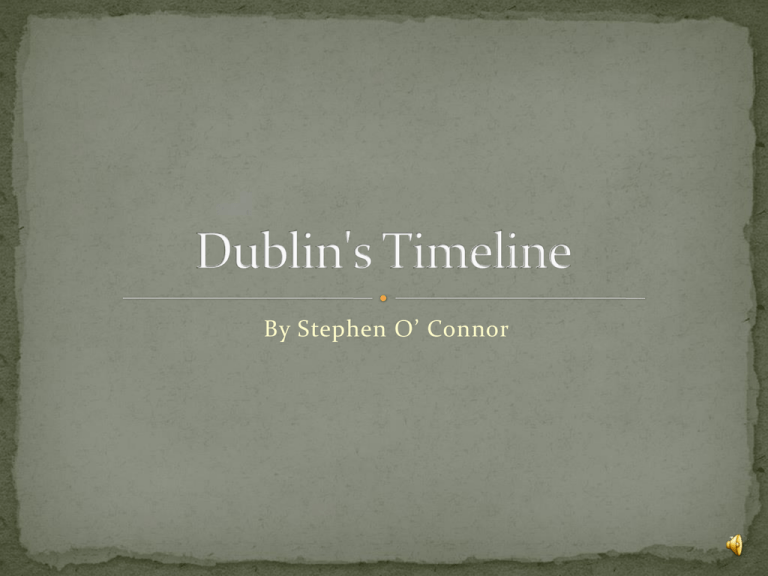
By Stephen O’ Connor 1 These are different times of the city of Dublin I will be talking about with you today: Celtic Times (250 BC – 1169) Viking Times (865 AD – 1066) Medieval Times (1066 – 1485) Tudor/Stuart Times (1485 – 1714) Georgian Times (1714 – 1837) Victorian Times (1837 1901) Modern Times (1901 – 2000’s) 2 The name Baile Atha Cliath means “ford of the hurdles" because Celtic people crossed the River Liffey on a bridge made of branches and hurdles. The first people settled in Dublin over 5000 years ago. The north side of the River Liffey was all farmland where people lived in huts with their animals. The Celts never lived in one place and left behind burial grounds. They gathered here to worship their Gods because they were pagans and didn't believe in one God. Today you can visit a Celtic burial ground in Coolock and Glasnevin. St. Patrick came to Ireland in the 5th century AD and spread christianity. Monks then wrote the Book of Kells by the 6th century AD. Its in Trinity College today. We celebrate St. Patrick on the 17th of March every year with a parade! CELTIC TIMES 3 In the 9th century Vikings from Scandinavia came up the River Liffey with 60 longboats. They lived on the banks of the River Liffey and built houses made of mud and wood called wattle. They brought blacksmiths, warriors, tradesmen, shipbuilders, artists and craftsmen who brought the coin to Ireland. FACT: They kept coins in their armpits using wax. They started Dublin on the road to becoming, a large port for buying & selling from Iceland to Russia. They also brought silk and spices to Irish markets and were the first to wear trousers . In 1014, the Irish King Brian Boru defeated the Vikings at the battle of Clontarf - Many Vikings married Irish people and their descendants are still here today. 4 In 1166, the Irish King Dermot MacMurrough sent for The Norman English to defeat the Leinster leader Strongbow. The Normans then took over all of Ireland. The Normans were great builders and built a stone wall around Dublin, the first stone bridge across the Liffey, and Dublin Castle. Guilds were formed by traders & craftsmen to help control trade and to support each other. In 1283, Christchurch went up in flames. In 1348, the Black Death came to Dublin carried by rats, the victims bodies were collected at night bought to a place in Dublin still known as Black Pitts. Dublin's population dropped by half. MEDIEVAL TIMES 5 After the Black Death crisis, in 1489 King Henry VII ordered a clean up of Dublin streets to stop disease spreading. By the 15th century, the Irish had won back most of Ireland. Dublin (also known as the “Pale”), was still loyal to Henry VIII and his son Edward VI, they then set up the Protestant Church causing a divide in the city. Dublin was still a busy port for wealthy merchants who built three-storey houses to live in. In 1560 Elizabeth I built three public clocks in Dublin. In 1592 Dublin's first university was built (Trinity College). In 1601 Elizabeth’s army defeated Hugh O Neill’s rebel Irish army. Oliver Cromwell’s reign caused Irish Catholics to go into hiding and go to church in secret within the city. TUDOR/ STUART TIMES 6 More bridges were built over the Liffey. The city had grown outside the medieval walls. The Parliament House, Custom House & Four Courts were built along with the Ha’Penny Bridge (1816). The city was beautiful, it had many things to do but in 1798 there was a rebellion led by Wolfetone. Dublin was a dangerous place to live because there were fights between Catholic & Protestant gangs. GEORGIAN TIMES 7 The Great Famine It began in 1845 – 1848. Potato blight spread disease. In 1847, 9000 people were fed per day in soup VICTORIAN TIMES kitchens. A house suited for one family was over crowded with people. Dublin continued to improve with railways and better sewage systems. The first train ran in 1834. Middle class people had jobs like lawyers, doctors, merchants or bankers but the people in slums worked in poor conditioned factories. Croke Park was built in 1884 for Irish games. 8 Irish Rebel British Rule: In Easter, 1916, a group led by Patrick Pearse took over the GPO and other key buildings. The British won and shot the 16 rebels in Kilmainham Gaol, which led to a bigger rebellion. In 1921, Michael Collins signed a treaty that split Ireland in two. MODERN TIMES In the 1930’s, slums became the new suburbs. Dublin was neutral in World War II. In the 1940’s, electricity was in many homes and cinemas were built in the city. In the 1950’s people went to Britain & America for work. The 1960’s, brought RTE, Supermarkets & Rock n’ Roll. Nelsons Pillar was blown up in 1966 and was replaced with the Spire in 2003. In 1974 there was the Dublin Bombings, killing 23 people. In 1986 Ireland suffered under a terrible recession. From 1995 – 2007 there was a financial boom called the Celtic Tiger and Ireland was very wealthy. 9 I used a book called ‘Children’s History of Dublin’ and got all my information from this. I found the Victorian Era the most interesting because of what I learnt about the Famine. 10 11
![South east presentation resources [pdf, 7.8MB]](http://s2.studylib.net/store/data/005225551_1-572ef1fc8a3b867845768d2e9683ea31-300x300.png)
